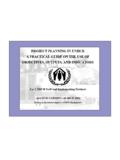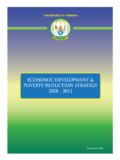Transcription of Global goals for oral health 2020 - WHO
1 International Dental Journal (2003) 53, 285 288 2003 FDI/World Dental Press0020-6539/03/05285-04 Global goals for oral health 2020 Martin HobdellHouston, USA, Leader of FDI Joint Working GroupPoul Erik PetersenWorld health Organisation, Geneva, SwitzerlandJohn ClarksonInternational Association for Dental Research, Alexandria, USAN ewell JohnsonFDI Science Commission, Ferney-Voltaire, FranceHow to use this documentIt is anticipated that dentists andother health planners in manydifferent circumstances will use thisdocument for guidance when devel-oping their plans for oral recognise that no documentcan provide an exact blue print foreach and every set of circumstanceswhere oral health plans are to bedeveloped. What is presented hereis a range of possible areas thatneed to be taken into considera-tion when plans are being devel-oped.
2 It also provides a usefulchecklist against which existingplans might be examined to deter-mine if there are any possible to the success ofany plan is a clear understanding ofwhat resources are already avail-able or might become availableonce the plan has been adoptedofficially. Initially it may not benecessary to have a detailed inven-tory of all resources available, asimple analysis like the completionof the questionnaire in Annexure Bwill give a quick guide as to thelevel of resources available to , combined with a prioritisedlist of the oral health problems ofthe community or population youare planning for, will help you iden-tify those types of interventions thatare likely to be most appropriateand sustainable under the prevail-ing FDI and the WHO establishedthe first Global oral health Goalsjointly in 1981 to be achieved bythe year 2000.
3 A review of thesegoals, carried out just prior to theend of this period, established thatthey had been useful and, for manypopulations, had been achieved orexceeded. However, for a signifi-cant proportion of the world spopulation, they remained only aremote aspiration. Nonetheless, theOral health goals had stimulatedawareness of the importance oforal health amongst national andlocal governments and acted as acatalyst for securing resources fororal health in general. Therefore,even though not all countries hadachieved the goals , they provided akey focus for the , the FDI, WHO andIADR have embarked on theactivity of preparing goals for thenew millennium, for the year 2020,and these are presented here. Theywere developed by a WorkingGroup including representatives ofthe FDI, WHO and IADR fromdifferent regions of the world (seeAnnexure A for the Group smembership).
4 The drafts of this documentwere circulated to all NationalDental Association members(NDAs) of the FDI and placed onthe Global Dental Public health listserver for comment. All WHOC ollaborating Centres in OralHealth (WHOCC) and the IADR were also consulted. Responsesreceived from NDAs, IADR,WHOCC as well as from individualshave subsequently been incorpo-rated in this document, which containsproposals for new Global OralHealth goals , Objectives andTargets of increasing detail andcomplexity, aims to provide aframework for health policymakers at different levels regional,national and local. The goals andtargets are not intended to beprescriptive. By being focusedbroadly on the Global level, it ishoped that it will encourage localaction in the spirit of the UnitedNations Development Programme sreport: Think globally act locally .Thus, the document will providean instrument for local and nationalhealth care planners to specify real-istic goals and standards for oralhealth to be achieved by the process of formulating aregional, national or local oral healthstrategy necessitates many document provides the firststep in that process by guidinghealth planners to evaluate thecurrent situation of oral health and286 International Dental Journal (2003) Vol.
5 53 oral health goals , objectives andtargets. The present goals differsignificantly from those of 1981 ina number of ways. First, they aremore general. Their purpose is tofacilitate regional, national andlocal oral health policy developmentand activities, leading to moredetailed and locally relevant previous goals , in their detail,are similar in scope to the presenttargets. Second, no absolute valuesare given, as these have to beestablished on the basis of localcircumstances such as the adequacyof the information base, localpriorities and oral health systems,as well as disease prevalence andseverity and situation will be differentnot only in so far as the epidemiol-ogy of oral diseases, but also withregard to the political, socio-econo-mic, cultural and legislative will require detailed knowledgeof the prevailing circumstances andthe significant determinants of oralhealth.
6 This knowledge is crucial tothe development of policies, whichaddress not only the immediateknown risk factors but also helpcreate a social, legislative and econo-mic environment that is conduciveto good oral following goals , objectivesand targets are proposed based oncurrent classifications of diseasesand established criteria for theirdiagnosis. After careful considera-tion of alternative ways of presentingthem, it was decided to set themout in the familiar way in relationto different groups of , Objectives and TargetsGoals1. To minimise the impact ofdiseases of oral and craniofacialorigin on health and psycho-social development, givingemphasis to promoting oralhealth and reducing oral diseaseamongst populations with thegreatest burden of such condi-tions and To minimise the impact of oraland craniofacial manifestationsof systemic diseases on individu-als and society, and to use thesemanifestations for early diagno-sis, prevention and effectivemanagement of systemic To reduce mortality from oraland craniofacial diseases2.
7 To reduce morbidity from oraland craniofacial diseases andthereby increase the quality oflife3. To promote sustainable, prior-ity-driven policies and pro-grammes in oral health systemsthat have been derived fromsystematic reviews of best prac-tices ( the policies are evidence-based)4. To develop accessible cost-effective oral health systems forthe prevention and control oforal and craniofacial diseases5. To integrate oral health promo-tion and care with other sectorsthat influence health , using thecommon risk factor approach6. To develop oral health pro-grammes that will empowerpeople to control determinantsof health7. To strengthen systems andmethods for oral health surveil-lance, both processes and out-comes8. To promote social responsibil-ity and ethical practices of caregivers9. To reduce disparities in oralhealth between different socio-economic groups within a coun-try and inequalities in oral healthacross increase the number ofhealth care providers who aretrained in accurate epidemio-logical surveillance of oraldiseases and the year 2020 the following willhave been achieved over baseline:1.
8 Pain: A reduction of X% in epi-sodes of pain of oral andcraniofacial origin A reduction of X% in thenumber of days absent fromschool, employment andwork resulting from pain oforal and craniofacial origin A reduction of X% in thenumber of people affectedby functional limitations (thiscovers a number of measur-able factors such as pain andimpairments, missing teeth,traumatised incisors andcongenital dental and facialanomalies A reduction of X% in theprevalence of moderate andsevere social impacts on dailyactivities resulting from pain,impairments and aesthetics(this includes missing teeth,dental anomalies, enameldefects such as fluorosis,traumatised incisors, severegingival recession and Functional disorders A reduction of X% in thenumbers of individualsexperiencing difficulties inchewing, swallowing covers a large numberof measurable factors relatedto tooth loss and congenitaland acquired Infectious diseases To increase by X% thenumbers of health careproviders competent torecognise and minimise therisks of transmission ofinfectious diseases in the oralhealth care Oro-pharyngeal cancer To reduce by X% the preva-lence of oro-pharyngealcancer To improve by X% the sur-vival (5-year survival rate) oftreated cases To increase early detectionby X% To increase rapid referral byX% 287 Hobdell et al.))
9 : Global goals for oral health 2020 To reduce exposure to riskfactors by X% with specialreference to tobacco, alco-hol and improved nutrition To increase by X% thenumber of affected individu-als receiving multidisciplinaryspecialist oral manifestations of HIVinfection To reduce by X% the preva-lence of opportunistic oro-facial infections To increase by X% thenumber of health providerswho are competent to diag-nose and manage the oralmanifestations of HIV infec-tion To increase by X% the num-bers of policy makers whoare aware of the oral impli-cations of HIV Noma To increase by X% data onNoma from populations atrisk To increase early detectionby X% To increase rapid referral byX% To reduce exposure to riskfactors by X% with specialreference to immunisationcoverage or measles,improved nutrition and sani-tation To increase by X% thenumber of affected individu-als receiving multidisciplinaryspecialist Trauma To increase early detectionby X% To increase rapid referral byX% To increase the number ofhealth care providers whoare competent to diagnoseand provide emergency careby/to X/Y% To increase by X% thenumber of affected individu-als receiving multidisciplinaryspecialist care where Craniofacial anomalies To reduce exposure to riskfactors by X% with specialreference to tobacco, alco-hol.
10 Teratogenic agents andimproved nutrition To increase access to geneticscreening and counselling byX% To increase early detectionby X% To increase rapid referral byX% To increase by X% thenumber of affected individu-als receiving multidisciplinaryspecialist care To increase early detectionof seriously handicappingmalocclusions and theirreferral by X%.9. Dental caries To increase the proportionof caries free 6-year-olds byX% To reduce the DMFT par-ticularly the D componentat age 12 years by X%, withspecial attention to high-riskgroups within populations,utilising both distributionsand means To reduce the number ofteeth extracted due to dentalcaries at ages 18, 35 44 and65 74 years by X%. anomalies ofteeth To reduce the prevalence ofdisfiguring dental fluorosis byX% as measured by cultur-ally sensitive measures andwith special reference to thefluoride content of food,water and inappropriatesupplementation To reduce the prevalence ofacquired developmentalanomalies of teeth by X%,with special reference toinfectious diseases and inap-propriate medications To increase early detectionby X% for both hereditaryand acquired anomalies To increase referral by X%for both hereditary andacquired diseases To reduce the number ofteeth lost due to periodontaldiseases by X% at ages 18,35 44 and 65 74 years withspecial reference to smok-ing, poor oral hygiene, stressand inter-current systemicdiseases To reduce the prevalence ofnecrotising forms of peri-odontal diseases by X% byreducing exposure to riskfactors such as poor nutri-tion.














